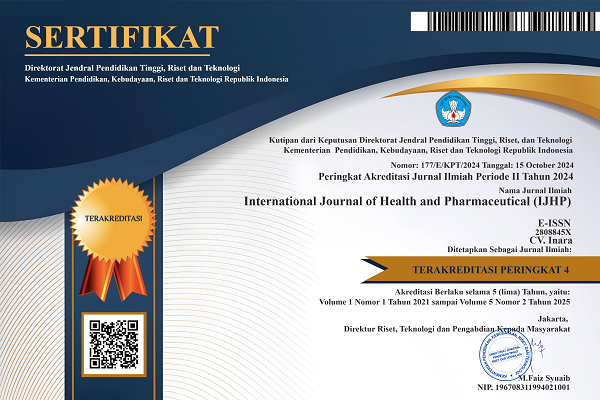The Anti-Aging Properties of Panax Ginseng: A Narrative Review of Mechanisms And Clinical Evidence
DOI:
https://doi.org/10.51601/ijhp.v5i1.361Abstract
Aging is a complex physiological process influenced by various factors including oxidative stress, inflammation, and cellular damage. Natural compounds, particularly Panax ginseng, have garnered significant interest in traditional medicine for their anti-aging potential. This study aims to comprehensively review the anti-aging properties of P. ginseng, examining its traditional applications, molecular mechanisms, and clinical evidence. A narrative review methodology was employed, analyzing data from PubMed, Scopus, and Google Scholar databases, incorporating both traditional knowledge and contemporary scientific research. Results demonstrate that P. ginseng exhibits significant anti-aging effects through multiple pathways: antioxidant activity, cellular regeneration enhancement, and collagen synthesis stimulation. Ginsenosides, the primary bioactive compounds, show particular efficacy in reducing oxidative stress and supporting cognitive function. However, challenges persist in standardizing clinical applications due to variations in ginsenoside content and study methodologies. While current evidence supports P. ginseng's therapeutic potential, standardized clinical trials are essential to establish optimal dosing protocols and evaluate long-term safety. Future research should address drug interactions and efficacy across diverse populations.
Downloads
References
Wang X., Fan X., Li Y., Zhou X., Zhang Z., Dong S.et al.. Research on the dentification of panax ginseng and panax quinquefolium using catalysed hairpin assembly technology. Phytochemical Analysis 2023;35(2):409-418.
Liu S., Wang S., Liu M., Yang F., Zhang H., Liu S.et al.. De novo sequencing and analysis of the transcriptome of panax ginseng in the leaf-expansion period. Molecular Medicine Reports 2016;14(2):1404-1412.
Yuan J., Chen Y., Liang J., Wang C., Liu X., Yan Z.et al.. Component analysis and target cell-based neuroactivity screening of panax ginseng by ultra-performance liquid chromatography coupled with quadrupole-time-of-flight mass spectrometry. Journal of Chromatography B 2016;1038:1-11.
Zhu G., Li Y., Hau D., Jiang Z., Yu Z., & Fong W.. Protopanaxatriol-type ginsenosides from the root of panax ginseng. Journal of Agricultural and Food Chemistry 2010;59(1):200-205.
Mostafa R., Shaffie N., & Allam R.. Panax ginseng alleviates thioacetamide-induced liver injury in ovariectomized rats: crosstalk between inflammation and oxidative stress. Plos One 2021;16(11):e0260507.
Shishtar E., Sievenpiper J., Djedovic V., Cozma A., Ha V., Jayalath V.et al.. The effect of ginseng (the genus panax) on glycemic control: a systematic review and meta-analysis of randomized controlled clinical trials. Plos One 2014;9(9):e107391.
Lee D., Park C., Lee S., Park H., Kim S., Son S.et al.. Anti-cancer effects of panax ginseng berry polysaccharides via activation of immune-related cells. Frontiers in Pharmacology 2019;10.
Kim J. and Cho S.. Ginseng berry and its biological effects as a natural phytochemical. Natural Products Chemistry & Research 2016;04(02).
Liu Y., He Q., Liu D., Wan W., Liu X., Wen C.et al.. Rp-hplcdetermination of ginsenosides rg1 and rb1 in panax ginseng fruits. African Journal of Traditional Complementary and Alternative Medicines 2015;12(2):12.
Wang C., Li S., Shen Y., Li Y., Chen M., Wang Y.et al.. Mechanisms of panax ginseng on treating sepsis by rna-seq technology. Infection and Drug Resistance 2022;Volume 15:7667-7678.
Zhao A., Liu N., Yao M., Zhang Y., Yao Z., Feng Y.et al.. A review of neuroprotective effects and mechanisms of ginsenosides from panax ginseng in treating ischemic stroke. Frontiers in Pharmacology 2022;13.
Zhang X., Khakisahneh S., Han S., Song E., Nam Y., & Kim H.. Ginseng extracts improve circadian clock gene expression and reduce inflammation directly and indirectly through gut microbiota and pi3k signaling pathway. NPJ Biofilms and Microbiomes 2024;10(1).
Gui Q., Xu Z., Xu K., & Yang Y.. The efficacy of ginseng-related therapies in type 2 diabetes mellitus. Medicine 2016;95(6):e2584.
Yang K., Ryu T., & Chung B.. A meta-analysis of preclinical studies to investigate the effect of panax ginseng on alcohol-associated liver disease. Antioxidants 2023;12(4):841.
Dik B., Avcı O., & Dik I.. In vitro antiviral and antioxidant activities of silymarin and panax ginseng on vero cells infected with bovine ephemeral fever virus and blue tongue virus. Acta Poloniae Pharmaceutica - Drug Research 2019;76(2):291-297.
Liang G., Yin J., Zhang Y., Ren H., Lou Y., Jiang H.et al.. Neuroprotective mechanisms of ginsenoside rb1 in central nervous system diseases. Frontiers in Pharmacology 2022;13.
Ding D., Liu S., Wang K., Huang L., & Jisheng Z.. Article expression, purification, and characterization of cu/znsod from panax ginseng. Molecules 2014;19(6):8112-8123.
Kim J., Cho S., Kim S., Cho D., Kim S., Park C.et al.. Effects of korean ginseng berry on skin antipigmentation and antiaging via foxo3a activation. Journal of Ginseng Research 2017;41(3):277-283.
Zhu J., Mu X., Zeng J., Xu C., Liu J., Zhang M.et al.. Ginsenoside rg1 prevents cognitive impairment and hippocampus senescence in a rat model of d-galactose-induced aging. Plos One 2014;9(6):e101291.
Park S., Shin Y., Kim H., Kim Y., Lee D., Hwang E.et al.. A single-center, randomized, double-blind, placebo-controlled study on the efficacy and safety of "enzyme-treated red ginseng powder complex (bg11001)" for antiwrinkle and proelasticity in individuals with healthy skin. Journal of Ginseng Research 2016;40(3):260-268.
Shin S., Lee J., Son D., Park D., & Jung E.. Anti-skin-aging activity of a standardized extract from panax ginseng leaves in vitro and in human volunteer. Cosmetics 2017;4(2):18.
Meng H., Liu X., Li J., Bao T., & Yi F.. Bibliometric analysis of the effects of ginseng on skin. Journal of Cosmetic Dermatology 2021;21(1):99-107.
Tan X., Gu J., Zhao B., Wang S., Yuan J., Wang C.et al.. Ginseng improves cognitive deficit via the rage/nf-κb pathway in advanced glycation end product-induced rats. Journal of Ginseng Research 2015;39(2):116-124.
Cristina-Souza G., Santos-Mariano A., Lima‐Silva A., Costa P., Domingos P., Silva S.et al.. Panax ginseng supplementation increases muscle recruitment, attenuates perceived effort, and accelerates muscle force recovery after an eccentric-based exercise in athletes. The Journal of Strength and Conditioning Research 2020;36(4):991-997.
Shi Z., Zeng J., & Wong A.. Chemical structures and pharmacological profiles of ginseng saponins. Molecules 2019;24(13):2443.
Erdle S., Chan E., Yang H., Vallance B., Mill C., & Wong T.. First-reported pediatric cases of american ginseng anaphylaxis and allergy. Allergy Asthma & Clinical Immunology 2018;14(1).
Downloads
Published
Issue
Section
License
Copyright (c) 2025 Komang Ayu Silfia Budiasih, Gede Eka Handrean

This work is licensed under a Creative Commons Attribution-NonCommercial 4.0 International License.























